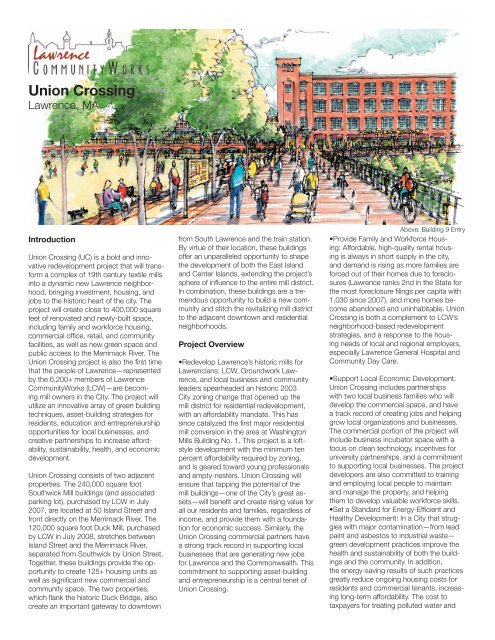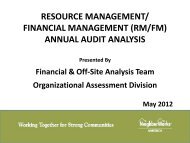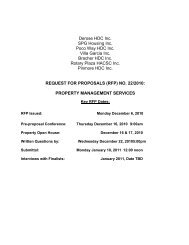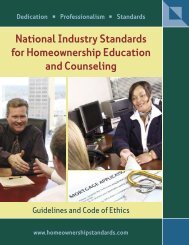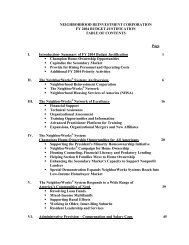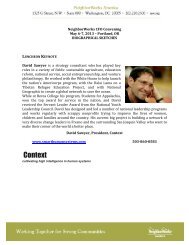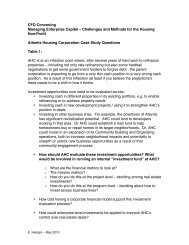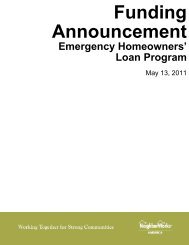Union Crossing Project fact sheet
Union Crossing Project fact sheet
Union Crossing Project fact sheet
You also want an ePaper? Increase the reach of your titles
YUMPU automatically turns print PDFs into web optimized ePapers that Google loves.
<strong>Union</strong> <strong>Crossing</strong><br />
Lawrence, MA<br />
Introduction<br />
<strong>Union</strong> <strong>Crossing</strong> (UC) is a bold and innovative<br />
redevelopment project that will transform<br />
a complex of 19th century textile mills<br />
into a dynamic new Lawrence neighborhood,<br />
bringing investment, housing, and<br />
jobs to the historic heart of the city. The<br />
project will create close to 400,000 square<br />
feet of renovated and newly-built space,<br />
including family and workforce housing,<br />
commercial offi ce, retail, and community<br />
facilities, as well as new green space and<br />
public access to the Merrimack River. The<br />
<strong>Union</strong> <strong>Crossing</strong> project is also the fi rst time<br />
that the people of Lawrence—represented<br />
by the 6,200+ members of Lawrence<br />
CommunityWorks (LCW)—are becoming<br />
mill owners in the City. The project will<br />
utilize an innovative array of green building<br />
techniques, asset-building strategies for<br />
residents, education and entrepreneurship<br />
opportunities for local businesses, and<br />
creative partnerships to increase affordability,<br />
sustainability, health, and economic<br />
development.<br />
<strong>Union</strong> <strong>Crossing</strong> consists of two adjacent<br />
properties. The 240,000 square foot<br />
Southwick Mill buildings (and associated<br />
parking lot), purchased by LCW in July<br />
2007, are located at 50 Island Street and<br />
front directly on the Merrimack River. The<br />
120,000 square foot Duck Mill, purchased<br />
by LCW in July 2008, stretches between<br />
Island Street and the Merrimack River,<br />
separated from Southwick by <strong>Union</strong> Street.<br />
Together, these buildings provide the opportunity<br />
to create 125+ housing units as<br />
well as signifi cant new commercial and<br />
community space. The two properties,<br />
which fl ank the historic Duck Bridge, also<br />
create an important gateway to downtown<br />
from South Lawrence and the train station.<br />
By virtue of their location, these buildings<br />
offer an unparalleled opportunity to shape<br />
the development of both the East Island<br />
and Center Islands, extending the project’s<br />
sphere of infl uence to the entire mill district.<br />
In combination, these buildings are a tremendous<br />
opportunity to build a new community<br />
and stitch the revitalizing mill district<br />
to the adjacent downtown and residential<br />
neighborhoods.<br />
<strong>Project</strong> Overview<br />
•Redevelop Lawrence’s historic mills for<br />
Lawrencians: LCW, Groundwork Lawrence,<br />
and local business and community<br />
leaders spearheaded an historic 2003<br />
City zoning change that opened up the<br />
mill district for residential redevelopment,<br />
with an affordability mandate. This has<br />
since catalyzed the fi rst major residential<br />
mill conversion in the area at Washington<br />
Mills Building No. 1. This project is a loftstyle<br />
development with the minimum ten<br />
percent affordability required by zoning,<br />
and is geared toward young professionals<br />
and empty-nesters. <strong>Union</strong> <strong>Crossing</strong> will<br />
ensure that tapping the potential of the<br />
mill buildings—one of the City’s great assets—will<br />
benefi t and create rising value for<br />
all our residents and families, regardless of<br />
income, and provide them with a foundation<br />
for economic success. Similarly, the<br />
<strong>Union</strong> <strong>Crossing</strong> commercial partners have<br />
a strong track record in supporting local<br />
businesses that are generating new jobs<br />
for Lawrence and the Commonwealth. This<br />
commitment to supporting asset-building<br />
and entrepreneurship is a central tenet of<br />
<strong>Union</strong> <strong>Crossing</strong>.<br />
Above: Building 9 Entry<br />
•Provide Family and Workforce Housing:<br />
Affordable, high-quality rental housing<br />
is always in short supply in the city,<br />
and demand is rising as more families are<br />
forced out of their homes due to foreclosures<br />
(Lawrence ranks 2nd in the State for<br />
the most foreclosure fi lings per capita with<br />
1,030 since 2007), and more homes become<br />
abandoned and uninhabitable. <strong>Union</strong><br />
<strong>Crossing</strong> is both a complement to LCW’s<br />
neighborhood-based redevelopment<br />
strategies, and a response to the housing<br />
needs of local and regional employers,<br />
especially Lawrence General Hospital and<br />
Community Day Care.<br />
•Support Local Economic Development:<br />
<strong>Union</strong> <strong>Crossing</strong> includes partnerships<br />
with two local business families who will<br />
develop the commercial space, and have<br />
a track record of creating jobs and helping<br />
grow local organizations and businesses.<br />
The commercial portion of the project will<br />
include business incubator space with a<br />
focus on clean technology, incentives for<br />
university partnerships, and a commitment<br />
to supporting local businesses. The project<br />
developers are also committed to training<br />
and employing local people to maintain<br />
and manage the property, and helping<br />
them to develop valuable workforce skills.<br />
•Set a Standard for Energy-Effi cient and<br />
Healthy Development: In a City that struggles<br />
with major contamination—from lead<br />
paint and asbestos to industrial waste—<br />
green development practices improve the<br />
health and sustainability of both the buildings<br />
and the community. In addition,<br />
the energy-saving results of such practices<br />
greatly reduce ongoing housing costs for<br />
residents and commercial tenants, increasing<br />
long-term affordability. The cost to<br />
taxpayers for treating polluted water and
disposing solid waste will also be substantially<br />
reduced in comparison with a conventionally-designed<br />
building. To the extent<br />
that <strong>Union</strong> <strong>Crossing</strong> can become a model<br />
for other local redevelopment projects,<br />
particularly in the mill district, its impact can<br />
be magnified.<br />
•Build Resident Assets and Wealth: LCW<br />
has a strong track record in helping hundreds<br />
of residents build skills and savings,<br />
further their education, start businesses,<br />
and buy homes. <strong>Union</strong> <strong>Crossing</strong> will<br />
include designated “wealth-creation” units<br />
linking residents to financial literacy training<br />
and matched savings that will enable them<br />
to build family stability and prosperity.<br />
•Promote Education and Wellness: <strong>Union</strong><br />
<strong>Crossing</strong> includes innovative partnerships<br />
with the City’s leading provider of<br />
early childhood education and Lawrence<br />
General Hospital. On-site childcare facilities,<br />
built-in wellness programming and<br />
health education, access to green space,<br />
and other physical and programmatic elements<br />
will help create a culture of wellness<br />
among residents. Better health translates<br />
into lower health-related expenses for our<br />
families.<br />
<strong>Project</strong> Benefits<br />
•125+ units of mixed-income family and<br />
workforce housing, including dedicated<br />
units for Lawrence General Hospital workers<br />
and young teachers<br />
•New day care center serving infants, toddlers,<br />
and pre-schoolers<br />
•Approximately 200 new jobs (including<br />
incubator space for start-up companies<br />
and small businesses)<br />
•New public access, green space, and<br />
eco-system restoration along the Merrimack<br />
River<br />
•Improved pedestrian, bike and vehicle<br />
circulation on the East Island and Center<br />
Islands<br />
•Re-use of former brownfield/ industrial<br />
sites<br />
•Innovative energy-efficiency features<br />
and on-site renewable energy systems to<br />
reduce operating costs and minimize or<br />
eliminate dependence on fossil fuels<br />
•Healthy home design will maximize indoor<br />
air quality and ambient comfort, reducing<br />
health risks for a vulnerable population<br />
(Lawrence has one of the highest pediatric<br />
Above: <strong>Union</strong> <strong>Crossing</strong> Site Plan<br />
asthma rates in the state)<br />
•Preservation and adaptive re-use of<br />
historic structures in a National Register<br />
Historic District<br />
•Collaborative, cost-effective, and efficient<br />
parking strategy: approx 475 spaces<br />
(including compact and shared spaces)<br />
provided on 50 Island St site—sufficient to<br />
support all existing and planned development<br />
at 50 Island, 56 Island, and 60<br />
Island St buildings; additional parking at<br />
4 <strong>Union</strong>/220 Canal to support redevelopment<br />
of the Duck Mill and potentially other<br />
projects in the area<br />
•Reduced costs to municipality for water<br />
supply, treatment, and waste disposal<br />
through innovative rain water harvesting,<br />
materials recycling, and composting<br />
systems<br />
•New tax revenues (approximately<br />
$225,000 annually to the City of Lawrence<br />
at full build-out)<br />
Energy efficiency and renewable<br />
energy<br />
The design of the <strong>Union</strong> <strong>Crossing</strong> site and<br />
buildings will seek to achieve the highest<br />
possible levels of performance in terms
Top Left: Building 4 Entry<br />
Top Right: Building 9- Second Floor Plan<br />
Bottom Right: <strong>Project</strong> Phasing Plan<br />
of both energy efficiency and renewable<br />
energy generation, thus reducing the consumption<br />
of fossil fuels and cutting utility<br />
costs for the building owner and residents.<br />
A recent analysis indicates that the first<br />
phase of <strong>Union</strong> <strong>Crossing</strong> (at Building 9)<br />
will use 81% less energy for heating than<br />
a conventional residential mill conversion,<br />
and will generate 50% less carbon emissions.<br />
The primary options for energy efficiency<br />
and renewable energy systems under consideration<br />
for <strong>Union</strong> <strong>Crossing</strong> are:<br />
•Efficient building envelope, ventilation<br />
system, lighting, and appliances<br />
• Multi-split air-to-air heat pumps for space<br />
heating and cooling<br />
•Solar thermal hot water system<br />
•Solar photovoltaic (PV) panels to generate<br />
electricity<br />
Developers<br />
The <strong>Union</strong> <strong>Crossing</strong> development team is<br />
a unique partnership between Lawrence<br />
CommunityWorks (LCW), a non-profit<br />
Development Corporation with a successful<br />
track record that includes more than<br />
$20 million of award-winning affordable<br />
housing and educational facilities over the<br />
past eight years, and two of Lawrence’s<br />
most successful commercial developers,<br />
the Yepez brothers and the Sidell family.<br />
Collectively, the developers bring a wealth<br />
of experience in residential and commercial<br />
real estate and have been leaders in<br />
the effort to redevelop the North Common<br />
neighborhood and the Reviviendo Gateway<br />
District in Lawrence.<br />
Partners<br />
LCW has signed Memoranda of Understanding<br />
with two key partners, both of<br />
which will be playing a central role in the<br />
project: Lawrence General Hospital and<br />
Community Day Care Centers of Lawrence.<br />
These partners will help anchor the<br />
project as tenants, and will work with the<br />
development team to plan, design and<br />
build a healthy community that offers highquality<br />
educational and economic opportunities<br />
for Lawrence families.<br />
LCW is also building on its long-standing<br />
and successful partnership with<br />
Groundwork Lawrence to help develop<br />
<strong>Union</strong> <strong>Crossing</strong>. To date, GWL has assisted<br />
with site design and facilitation of<br />
community meetings during the Master<br />
Planning phase, which concluded in April<br />
2008. GWL will continue to play a key<br />
role in guiding the further design of the<br />
green features, including: the pedestrian<br />
walkway and green deck, community gardens,<br />
recycling/composting, storm water<br />
management and river walk. GWL will also<br />
be working closely with LCW to develop<br />
educational programming that ensures<br />
these elements can be successfully and<br />
affordably maintained over the life of the<br />
project.<br />
LCW is also partnering with MIT@Lawrence<br />
and the Lawrence History Center to<br />
document and interpret the history of the<br />
site and to display the information in innovative<br />
ways. Two groups of local high<br />
school students, one from Movement City<br />
(LCW’s youth program), and the Green<br />
Team (GWL’s youth program), are working<br />
with students and faculty from MIT, staff<br />
and volunteers from the Lawrence History<br />
Center and the Lawrence Heritage State<br />
Park, a local sound engineer and local<br />
filmmaker to interview employees at the<br />
Southwick <strong>fact</strong>ory before they move to<br />
their new facility in Haverhill, capture the<br />
sights and sounds of the <strong>fact</strong>ory in operation,<br />
and interview project team members<br />
in order to capture “history in progress” as<br />
this nineteenth-century industrial property<br />
is transformed into a new sustainable<br />
community. MIT students will work with<br />
this team to organize the information and<br />
create prototypes for site signage, radio<br />
programs, podcasts, a video documentary,<br />
and/or a web portal to share this information<br />
with the global community.<br />
Sources of Funding<br />
Upon completion, <strong>Union</strong> <strong>Crossing</strong> will represent<br />
an investment of approximately $75<br />
million+ from a variety of public and private<br />
sources. We have identified many of these<br />
funding sources already, including<br />
Low-Income Housing Tax Credits, state<br />
and federal historic tax credits, new market<br />
tax credits, Renewable Energy credits,<br />
HOME funds, Affordable Housing Trust<br />
funds, EPA Brownfield funds, Mass Technology<br />
Collaborative funds, utility rebate<br />
programs, private-sector Foundation support,<br />
and conventional bank financing.<br />
Phasing<br />
•PHASE ONE (targeted construction start<br />
in 2009)<br />
•PHASE TWO (targeted construction start<br />
in 2010)
Community Involvement<br />
LCW and the UC partners are committed<br />
to a community-driven planning process at<br />
every stage of the project. During the master<br />
planning phase alone LCW organized<br />
six community events to solicit ideas and<br />
feedback. As the project moves forward,<br />
we will continue to seek community-based<br />
solutions that address the objectives we<br />
have established for <strong>Union</strong> <strong>Crossing</strong>.<br />
Newcomers are encouraged to volunteer<br />
with the <strong>Union</strong> <strong>Crossing</strong> Committee.<br />
Currently, the Committee includes local<br />
residents and business owners who have<br />
committed to serve for one year, and to<br />
consistently participate in project planning.<br />
In addition to the full committee, volunteers<br />
and students are participating in smaller<br />
sub-committees to guide the building design,<br />
site design, and local hiring process.<br />
Community meetings follow a variety of<br />
formats. Volunteers participate in site<br />
visits to comparable projects, get updates<br />
from the design team, and engage in small<br />
group discussions. These small group<br />
discussions enable members to explore<br />
specific ideas/programs/decisions in depth<br />
and then report their findings and recommendations<br />
to the larger Committee. The<br />
Top: Dye Works Building Roof Deck<br />
Bottom: Neighborhood Context<br />
goal of the Committee is to add one new<br />
community volunteer at each Committee<br />
meeting.<br />
Moving forward in the design and eventual<br />
construction process, LCW will look for<br />
opportunities to employ local residents in<br />
these efforts. In order for this project to<br />
succeed, LCW needs your support. You<br />
can contribute to the success of <strong>Union</strong><br />
<strong>Crossing</strong> by coming to a Committee meeting,<br />
signing a letter of support, or by just<br />
staying informed about the project and<br />
spreading the word to your friends and colleagues.<br />
We look forward to hearing from<br />
you; please contact Dan Koff at 978-722-<br />
2621 to join our planning sessions or be<br />
involved in any way.<br />
Additional Information<br />
For more information and to see the<br />
complete Master Plan please visit the client<br />
area at:<br />
www.coldhamandhartman.com<br />
Username: union<br />
Password: crossing<br />
(all lowercase)


